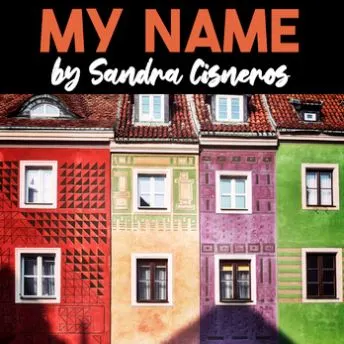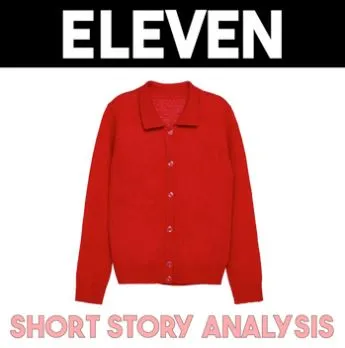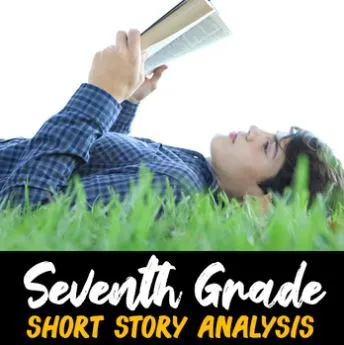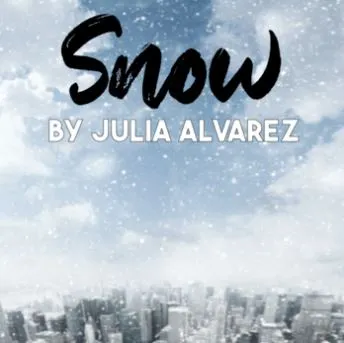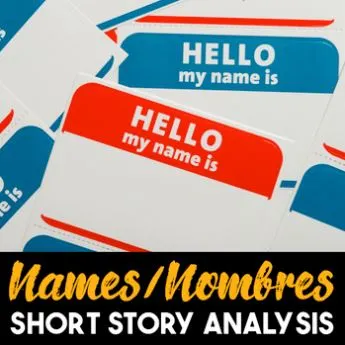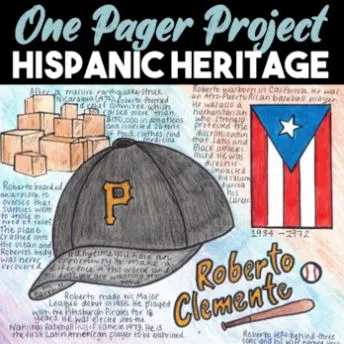Celebrate Hispanic Heritage Month by sharing any (or all) of these 13 short stories with your students. Written by Hispanic authors, these short stories are the perfect way to honor and celebrate the work of Hispanic and Latin American writers.
The Importance of Teaching During Hispanic Heritage Month– And Beyond.
Whether you’ve stumbled upon this article in the midst of Hispanic Heritage Month (September 15th-October 15th) or are planning ahead, I applaud you for your commitment to inclusivity and culturally responsive teaching.
Let’s face it– teachers have a unique opportunity and, some would say, obligation to prepare students for the world beyond the walls of any classroom or school. That means looking beyond state standards and class curricula and holding a mirror to the diverse world in which we live.
It also means taking advantage of the opportunity to expose students to a wide variety of American perspectives. After all, whether you call it the great melting pot or salad bowl, there’s no denying the mix of perspectives that come together to paint a picture of the American experience.
Regardless of how diverse (or not) your district and classroom is, the truth is, culturally responsive teaching promotes perspective, tolerance, empathy, and overall kindness both in and out of the classroom. And I think we could all agree we could use more of those in modern times, right? (Right.)
Using Short Stories To Teach During Hispanic Heritage Month.
So, if you’re looking to expand beyond the classic literary canon and include more Hispanic voices in your classroom, short stories are the perfect way to start. From Sandra Cisneros, the beloved author of The House on Mango Street, to the highly relatable Gary Soto, I’ve put together a list of 13 of my favorite short stories (and authors!) to teach during Hispanic Heritage Month.
Including any of these 13 short stories or authors in your classroom is a great way for you and your students to celebrate the literary contributions of Hispanic and Latino Americans. And while these authors deserve a place in our bookshelves and curriculums all year long, this month is the perfect opportunity to dig a little deeper into these author’s literary works and the experiences and perspectives they represent.
Afterall, literature is often used as a way to help students hold a mirror to their experiences and the world they know. But opportunities like Hispanic Heritage Month serve as a reminder that literature can also open students’ eyes to relevant perspectives they may not understand. In that case, let these short stories serve as a window into the diverse American experience.
So,without further adieu, read on for a glimpse into my favorite authors and short stories perfect for bringing a touch of Hispanic and Latino heritage into your classroom.
Short Stories To Teach During Hispanic Heritage Month By Sandra Cisneros
While Sandra Cisneros has penned several beautiful short stories perfect to teach during Hispanic Heritage Month, she is best known for her popular coming-of-age novel, The House On Mango Street. (Haven’t read it? I highly recommend adding it to your list– or at least your classroom library!) As a dual citizen of the United States and Mexico, Cisneros’ short fiction reflects very real experiences and emotions of those feeling a sense of “otherness.” While she most certainly pays homage to the Hispanic American experience, there is plenty to be read between the lines to promote self-to-text connections among students of various ages and backgrounds.
- “My Name” by Sandra Cisneros
Okay, you caught me. Technically this is a vignette from Cisneros’ novel, The House on Mango Street. However, “My Name” is often taught as a short story due to its highly relatable undertone and powerful message. In the story, protagonist Esperanza uses her name to show the stark contrast between Mexican and American culture. Furthermore, the story represents her experience trying to find her place in each. As you read, have students pay attention to how the narrator toes the line between respecting her heritage and revealing her desire to pave her own path.
“My Name” calls to attention a big question around identity: What’s in a name? After reading Cisneros’ vignette and exploring Esperanza’s thoughts regarding her name, engage students in a conversation regarding their own identities. In fact, you can have students write their own version of “My Name” to explore and unpack the many facets of their identity. How fun!
- “Eleven” by Sandra Cisneros
At first glance, “Eleven” appears to be a simple story about a traumatic event experienced by a young girl on her birthday– in class of all places. (Tap into your 11-year-old self and I’m sure you can relate to the horror.) However, upon a deeper look, this story reveals a struggle of facing unjust assumptions and stigmas. Therefore, this story is a great opportunity to challenge students to consider additional struggles certain people face on top of the universal growing pains. (I’m looking at you pre-teen awkwardness.)
Despite the protagonist’s young age, Cisneros tells the story with a poignant maturity, shining a light on its deeper meaning. Furthermore, the use of descriptions such as “pennies in a tin Band-Aid Box,” “runaway balloons,” “smell[ing] like cottage cheese,” provide a great look into Cisneros’ skillful use of literary devices like similes and metaphors. Thus, Cisneros juxtaposes child-like words with mature emotions, creating a unique story with the ability to pack a punch.
- “Barbie-Q” by Sandra Cisneros
Another short, but powerful piece by Cisneros, “Barbie-Q” can be interpreted in many ways. One thing not up for debate, however, is the stark contrast between the ragged dolls the narrator plays with and the idealistic and “new” Barbies attained by other girls. Students can dive into this tale, looking at the themes of economic disparity, gender identity, or stereotypes. Afterall, Barbie herself very well may stand as a representation of “white” beauty unattainable by the story’s narrator.
Therefore, Cisneros’ short story opens the door for a conversation around a sense of “otherness” popular toys and products can inherently promote. This can be a great way to discuss the idea of “otherness” and the ways in which society portrays certain identities more than others. Thus, leading to one of the story’s most pertinent questions: in desiring these dolls, are the girls being led down a path of devaluing their identity or do they show a sense of pride and acceptance? Or, perhaps, in the innocence of childhood, are the girls unaware of the contrasts at all? (Let the conversation commence!)
*Teacher tip: Due to an instance of inappropriate language, I recommend reading through this text before deciding to share it with your students.
Short Stories To Teach During Hispanic Heritage Month By Gary Soto
As a child of working-class Mexican American parents, Gary Soto’s works often reflect his experiences growing up in the poverty-stricken barrios of Fresno, California. Inspired by his own struggles, Soto aims to reach young readers who may be experiencing something similar– regardless of race or ethnicity. In fact, his universal themes and conversational language are what make his stories so relatable to all. Therefore, while many of his story’s characters and conflicts reflect his own as a Mexican-American, his works are remarkably relatable to students of all ages and backgrounds.
- “The Jacket“ by Gary Soto
Not only is Soto’s “The Jacket” a powerful short story, but it’s a great way to introduce the genre of memoir into your classroom. Rooted in real events and feelings from his childhood, Soto’s story serves as both a personal reflection and a unifying tale. By exploring popular coming-of-age themes such as identity and insecurity, Soto lays the foundation not only for a detailed analysis, but impactful connections and conversations as well.
As hinted at by the title, Soto’s childhood jacket plays a leading role in this story. (Some may call it a main character.) Soto skillfully employs the symbolism of the jacket to portray his family’s poverty and the impact it had on his self-image and confidence. Through the short story, it is clear Soto blames the “enemy” jacket for his bad luck during his middle school experience. However, on a deeper level, students are able to unpack what that really means. As they track the symbolism of the jacket, have them consider the ways in which a physical object can reflect an emotional experience in this story and beyond.
- “Seventh Grade” by Gary Soto
Perhaps one of Soto’s most widely taught and most relatable stories is “Seventh Grade.” Following Victor and his attempt to connect with his crush, Soto crafts a highly relatable coming-of-age story. (Yep. It’s kind of his thing.) A story where the protagonist is searching for a sense of belonging and acceptance? Relatable. Attempting to change oneself to fit in or impress others? Yep. In other words, students will cringe and laugh as they recall their own pre-teen days while reading, sympathizing for Victor on a whole new level.
Additionally, “Seventh Grade” is an excellent opportunity to dive into Soto’s skillful characterization. By asking students to track how Victor changes over the course of the story, they can pay close attention to the vivid character descriptions and overall character development. Have them take a look at what Victor says and how he acts and responds to others as a way to reveal his character.
- “Mother and Daughter” by Gary Soto
Another tale juxtaposing the struggles of adolescence and poverty, this short story follows the relationship between Mrs. Moreno and her daughter Yollie. Having come to America from Mexico, the family struggles with poverty. And, despite Mrs. Moreno’s dedication to her daughter’s happiness, Yollie easily gets caught up in her desires to have things they cannot afford. (Why? In search of acceptance, of course.) Therefore, regardless of her acknowledgement that their poverty isn’t her mother’s fault, Yollie struggles with the impact their financial situation has on her self-image and confidence.
Soto crafts a beautiful story showing the lengths a mother will go to provide for her child, despite limitations and financial hardships. While Yollie spends much of the story wanting what she cannot have, her mother is simply doing her best to provide for her family. Students can track the mother-daughter relationship as well as Soto’s use of the “black dress” to represent Yollie’s identity struggles.
Short Stories To Teach During Hispanic Heritage Month By Julia Alvarez
Despite being born in New York City, Julia Alvarez spent the first ten years of her life in her parent’s native country, the Dominican Republic. However, they were forced to return to the city due to political unrest in the country. With that said, it’s no wonder that the immigrant experience of navigating two cultures is at the center of much of her work. Whether writing poetry, short stories, or novels, Alvarez’s writing often reflects the experiences and struggles facing stereotypes, alienation, and prejudice.
- “Snow” by Julia Alvarez
On the surface, “Snow” is a story about a young immigrant girl named Yolanda experiencing New York snow for the first time. However, upon a closer look, Alvarez captures the emotional struggle of adapting to a new culture, especially during a time of great turmoil. As if learning a new culture isn’t a challenge enough, Alvarez highlights how the transition goes beyond the obvious elements of finding ones in a new environment.
Immigrating to the U.S. during the Cuban Missile Crisis, Yolanda must navigate learning a new language during the wide-spread fear of a nuclear attack. After learning terms like “nuclear bomb” and “radioactive” fallout alongside everyday terms such as “laundromat” and “subway,” Yolanda mistakenly (and fearfully) believes snow to be the ashy fallout from a nuclear bomb. Thus, Alvarez calls attention to the layers of difficulties when it comes to adjusting to not only a new language, but a new culture as a whole. Upon reading this short story, consider asking students to reflect on the impact of Yolanda’s first-person narration in Alvarez’s underlying message.
- “Names” by Julia Alvarez
What’s in a name, you ask? Reading Alvarez’s “Names” can certainly provide a conversation-worthy answer. (And, perhaps, would be great to pair with Cisneros’ “My Name.”) Written as a reflection of assimilation to “Americanized” names over the course of her life, Alvarez employs her literary talents to express the difficulties of fitting in while remaining prideful in your identity as an immigrant. (Or any outsider for that fact.) Thus, Alvarez shows the paradox of her pride in her family and their heritage and her desire to belong.
Alvarez begins the story with a powerful anecdote about arriving in New York City and having her Dominican family name mispronounced, setting the stage for the rest of the piece. As students search the text for other anecdotes, ask them to analyze the great impact Alvarez’s experiences with her name have had on her sense of self. The story will hold your attention until the final lines, where you can challenge students to unpack how those final lines reveal a sense of Alvarez’s ongoing duality.
- “My First Free Summer” by Julia Alvarez
Most of the other stories on this list take place in America. However, “My First Free Summer” primarily takes place in the Dominican Republic. The story leads up to Alvarez and her family’s move to America. A powerful memoir detailing her experience of getting to America, Alvarez gives a more historical look into the immigrant experience. “We raced off, wondering how to fit the contents of our Dominican lives into four small suitcases,” Alvarez writes, emphasizing a sense of “otherness” experienced by those preparing to assimilate to a new culture. And yes, the story is written from a child’s perspective. However, a sense of innocence is nearly lost as Alvarez details the moment at the airport when her parents’ sense of “terror ” became her own.
While it could be said that this “free summer” is a symbol of her freedom from summer school, it can also be representative of her freedom from a harsh dictatorship. However, students can spend time diving into the contrasting senses of gaining freedom and losing a sense of belonging. Perhaps they too can relate to a time where freedom came at the cost of comfort.
Other Powerful Short Stories To Teach During Hispanic Heritage Month
- “American History” by Judith Ortiz Cofer
Having spent much of her childhood split between her native Puerto Rico and America, Cofer’s “American History” beautifully captures her experience with cultural isolation and its impact on one’s identity. Written from the perspective of 14-year-old Puetro Rican immigrant Elena, the story outlines her struggles fitting in in the face of stereotypes and stigmas. While Elena attempts to befriend her new neighbor, Cofer shows how easily stereotypes and stigmas can get in the way. WHile this struggle appears to make up most of the story, the final punch comes right at the very end. In the wake of President JFK’s assassination, Elena struglges to find a true connection to the American tragedy.
Cofer does an incredible job using Elena and her experiences to express the identity struggles she and several other immigrants faced during the 60s. Upon taking a closer look at Cofer’s descriptions and Elena’s reactions to her neighbor’s judgmental and dismissive attitude, students can have a deeper understanding of the impact of such instances on one’s identity.
- “The Scholarship Jacket” by Marta Salinas
First published in 1986, Salinas’ “The Scholarship Jacket” continues to be widely read in the secondary classroom. As a Mexican American herself, Salinas channels the perspective of a young Mexican American girl facing a heartbreaking injustice at school.
While hard-working Martha wants nothing more than to earn the school’s “Scholarship Jacket,” issues of racism, politics, and poverty get in the way.
Aside from discussing the story’s powerful theme of injustice, students can dive into Salinas’ skillful writing. Written in the first person, the story provides unique insight into the narrator’s experience. Have students take notes on how Salinas employs descriptive language and word choice to paint a stronger picture of Martha’s perspective throughout the story.
- “A Very Old Man with Enormous Wings” by Gabriel García Márquez
Most often recognized for his novel One Hundred Years of Solitude, the late Gabriel García Márquez is known for his magical realism. While magical realism is a popular genre among Latin American authors, it’s known as the signature style of Colombian-born Márquez. Perhaps the most complicated text on the list, this story is the perfect example of the genre. The story follows the relationship between a struggling family and an angel-like old man– despite his disheveled appearance, that is. However, over the course of the story, Marguez skillfully uses juxtapositions to highlight that the only thing getting in the way of a miraculous life is man’s inability to see the beauty in what’s before us.
With folklore and storytelling playing imperative roles in Hispanic culture, students can use this story to understand and appreciate how magical realism blends hispanic culture with literary norms. As they read, ask students to track the fairy-tale-like descriptions employed by Márquez. Follow up with a discussion on how those elements add to the overall tone and theme of the story.
- “Sol Painting, Inc.” by Meg Medina
Meg Medina is a Cuban American writer whose stories focus on how a person’s family, culture, and heritage influence them. This story teaches different points of view the characters can have in a situation. It also touches on social issues such as a female wanting to be in a trade career. It goes into race issues with the family being Cuban in a white area.
“Sol Painting Inc.” is about a 12-year-old girl named Merci who wants to grow up and run her father’s painting business even though her mother does not approve of this dream. In exchange for his children’s tuition at a fancy private school, Merci’s father agrees to paint the gymnasium and a few classrooms. Merci’s brother is embarrassed by this deal and he is ashamed of his father’s painting business. Tensions grow even higher when some girls from the school carelessly damage the paint job the family had just completed.
Teaching During Hispanic Heritage Month: Beyond the Short Story
Why stop at short stories? Whether you’re looking to dig deeper into HIspanic voices or to simply to add titles to your classroom library, be sure to check out the following titles your students are sure to enjoy:
- I Am Not Your Perfect Mexican Daughter by Erika Sánchez is a fantastic read that secondary students will find both touching and humorous.
- As mentioned earlier in this post, Sandra Cisneros’ classic The House on Mango Street is well read (and top ranking) for a reason.
- Dive deeper into Julia Alvarez’s escape from the Dominican dictatorship with her historical novel In the Time of the Butterflies.
- The Book of Unknown American by Cristina Henriquez is both beautiful and tragic, offering a glimpse into the lives of immigrant teens and their families.
- Between it’s pop culture references and poignant prose, The Brief Wondrous Life of Oscar Wao by Junot Díaz is a story students will find relatable, humorous, and all around enjoyable. (Plus, it’s a great opportunity to see magical realism in full swing.)
A Final Word on Teaching Short Stories During Hispanic Heritage Month.
By no means is this an exhaustive list. In fact, some might say it barely scratches the surface. Yes, I invite you to bring any (or all) of these authors and titles into your classroom. However, I also encourage you to find even more Hispanic stories and voices to share with your students during Hispanic Heritage Month (and beyond). And if you do, I encourage you to share them with other teachers.
Together we can show the students of today and tomorrow just how diverse the American experience is. Remember, the goal isn’t simply to check these titles off the list. It’s an opportunity to pay respect to the many powerful and impactful voices of great American literature. And while the short stories mentioned above are fantastic reads, they open the door for even more powerful conversations that can help shape our students and the future they will lead.

